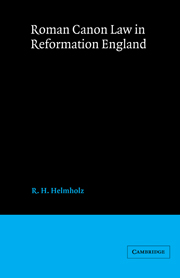Book contents
- Frontmatter
- Contents
- Preface
- List of abbreviations
- Table of statutes
- Table of cases
- 1 THE MEDIEVAL INHERITANCE
- 2 THE FORTUNES OF ECCLESIASTICAL JURISDICTION
- 3 DEVELOPMENTS IN LAW AND LEGAL PRACTICE
- 4 THE LITERATURE OF CIVILIAN PRACTICE
- 5 THE CIVILIANS AND ENGLISH COMMON LAW
- Appendix 1 Manuscript copies of Clerke's Praxis
- Appendix 2 Ecclesiastical reports, 1580–1640
- Index
3 - DEVELOPMENTS IN LAW AND LEGAL PRACTICE
Published online by Cambridge University Press: 24 November 2009
- Frontmatter
- Contents
- Preface
- List of abbreviations
- Table of statutes
- Table of cases
- 1 THE MEDIEVAL INHERITANCE
- 2 THE FORTUNES OF ECCLESIASTICAL JURISDICTION
- 3 DEVELOPMENTS IN LAW AND LEGAL PRACTICE
- 4 THE LITERATURE OF CIVILIAN PRACTICE
- 5 THE CIVILIANS AND ENGLISH COMMON LAW
- Appendix 1 Manuscript copies of Clerke's Praxis
- Appendix 2 Ecclesiastical reports, 1580–1640
- Index
Summary
Three principal features emerged from surveying the outer framework of ecclesiastical jurisdiction during the years of the Reformation. First, serious attempts to work root and branch reform of the court system came to nothing. Not all men had given up hopes for substantial reform as Elizabeth's reign went on, but more and more it looked as though the courts would follow the pattern set during the reign of her father. That meant continued enforcement of the Roman canon law, in so far as it was compatible with the settled customs of the country and the interests of the English Crown. Second, the principle that Parliament could legislate directly for the ecclesiastical courts was accepted in principle and implemented in fact. Statute law became a regular feature of practice within the spiritual forum. Third, the volume of litigation in the courts grew during the course of Elizabeth's reign. Both on the instance and the ex officio sides, more causes were being heard in 1600 than had been true fifty or even one hundred years before. This third development signalled, if it did not wholly cause, some restoration of confidence among the civilians who staffed the ecclesiastical tribunals.
This chapter looks inside the outer framework. It describes the legal developments that occurred in five specific areas of post-Reformation court practice, attempting to show what continuities and changes they entailed. Its purpose is thus to add legal flesh and bones to my account of the jurisdictional developments, and to show in detail how the spiritual courts coped with the changed circumstances brought about by the Reformation.
- Type
- Chapter
- Information
- Roman Canon Law in Reformation England , pp. 55 - 120Publisher: Cambridge University PressPrint publication year: 1990

